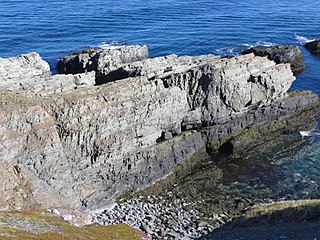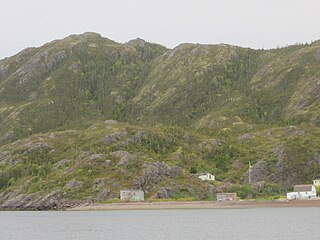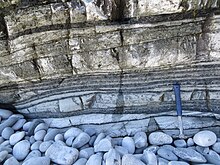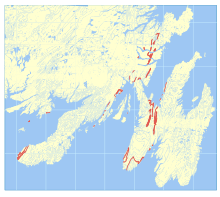
The Cambrian Period was the first geological period of the Paleozoic Era, and of the Phanerozoic Eon. The Cambrian lasted 53.4 million years from the end of the preceding Ediacaran Period 538.8 million years ago (mya) to the beginning of the Ordovician Period 485.4 mya. Its subdivisions, and its base, are somewhat in flux. The period was established as "Cambrian series" by Adam Sedgwick, who named it after Cambria, the Latin name for 'Cymru' (Wales), where Britain's Cambrian rocks are best exposed. Sedgwick identified the layer as part of his task, along with Roderick Murchison, to subdivide the large "Transition Series", although the two geologists disagreed for a while on the appropriate categorization. The Cambrian is unique in its unusually high proportion of lagerstätte sedimentary deposits, sites of exceptional preservation where "soft" parts of organisms are preserved as well as their more resistant shells. As a result, our understanding of the Cambrian biology surpasses that of some later periods.

The Ediacaran Period is a geological period that spans 96 million years from the end of the Cryogenian Period 635 million years ago (Mya), to the beginning of the Cambrian Period 538.8 Mya. It marks the end of the Proterozoic Eon, and the beginning of the Phanerozoic Eon. It is named after the Ediacara Hills of South Australia.
The Precambrian is the earliest part of Earth's history, set before the current Phanerozoic Eon. The Precambrian is so named because it preceded the Cambrian, the first period of the Phanerozoic Eon, which is named after Cambria, the Latinised name for Wales, where rocks from this age were first studied. The Precambrian accounts for 88% of the Earth's geologic time.

Charnia is a genus of frond-like lifeforms belonging to the Ediacaran biota with segmented, leaf-like ridges branching alternately to the right and left from a zig-zag medial suture. The genus Charnia was named after Charnwood Forest in Leicestershire, England, where the first fossilised specimen was found. Charnia is significant because it was the first Precambrian fossil to be recognized as such.

Glauconite is an iron potassium phyllosilicate mineral of characteristic green color which is very friable and has very low weathering resistance.

Aspidella is an Ediacaran disk-shaped fossil of uncertain affinity. It is known from the single species A. terranovica.

The Ediacaranbiota is a taxonomic period classification that consists of all life forms that were present on Earth during the Ediacaran Period. These were composed of enigmatic tubular and frond-shaped, mostly sessile, organisms. Trace fossils of these organisms have been found worldwide, and represent the earliest known complex multicellular organisms.

The Stephen Formation is a geologic formation exposed in the Canadian Rockies of British Columbia and Alberta, on the western edge of the Western Canada Sedimentary Basin. It consists of shale, thin-bedded limestone, and siltstone that was deposited during Middle Cambrian time. It is famous for the exceptional preservation of soft-bodied fossils: the Burgess Shale biota. The formation overlies the Cathedral escarpment, a submarine cliff; consequently it is divided into two quite separate parts, the 'thin' sequence deposited in the shallower waters atop the escarpment, and the 'thick' sequence deposited in the deeper waters beyond the cliff. Because the 'thick' Stephen Formation represents a distinct lithofacies, some authors suggest it warrants its own name, and dub it the Burgess Shale Formation. The stratigraphy of the Thin Stephen Formation has not been subject to extensive study, so except where explicitly mentioned this article applies mainly to the Thick Stephen Formation.

Syneresis cracks are a sedimentary structure developed by the shrinkage of sediment without desiccation – not to be confused with desiccation cracks. Syneresis is the expulsion of a liquid from a gel-like substance. Syneresis cracks are formed by the contraction of clay in response to changes in the salinity of a liquid surrounding a deposit. The cracks can occur, for example, in mudstones deposited between two beds of sandstone. The markings would have been formed subaqueously on the bedding surface and could resemble desiccation mudcracks, but are not continuous and vary in shape. They commonly occur in thin mudstones interbedded with sandstones, as positive relief on the bottom of the sandstone, or as negative relief on the top of the mudstone. Subaqueous shrinkage cracks can develop on and through a surface that has been continuously covered in water. Syneresis cracks in some shales and lime mudstones may initially be preserved as small cavities, which then usually fill with silt and sand from either the overlying or underlying beds and laminae. Usually there is no pattern to the cracks, and they do not connect to form geometric shapes. Rather they are discontinuous and shaped in one of the following categories:

The Chapel Island Formation is a sedimentary formation from the Burin Peninsula, Newfoundland, Canada. It is a succession of siliciclastic deposits, over 1,000 metres (3,300 ft) thick, that were deposited during the latest Ediacaran and earliest Cambrian.

The Nama Group is a 125,000 square kilometres (48,000 sq mi) megaregional Vendian to Cambrian group of stratigraphic sequences deposited in the Nama foreland basin in central and southern Namibia. The Nama Basin is a peripheral foreland basin, and the Nama Group was deposited in two early basins, the Zaris and Witputs, to the north, while the South African Vanrhynsdorp Group was deposited in the southern third. The Nama Group is made of fluvial and shallow-water marine sediments, both siliciclastic and carbonate. La Tinta Group in Argentina is considered equivalent to Nama Group.

Arumberia is an enigmatic fossil from the Ediacaran period originally described from the Arumbera Sandstone, Northern Territory, Australia but also found in the Urals, East Siberia, England and Wales, Northern France, the Avalon Peninsula and India. Several morphologically distinct species are recognized.
The Brigus Formation is a fossiliferous upper lower Cambrian geologic formation in Newfoundland and Labrador.

The Mistaken Point Formation is a geologic formation in Newfoundland and Labrador. It is recognized as a Lagerstätte preserving fossils dating back to the Ediacaran period. It contains a stratum dated to 565 ± 3 million years ago.
The Ingta Formation is a geological unit containing green sandstones and shales; it crops out in the Canadian Mackenzie Mountains. Its age is poorly constrained, though it straddles the Precambrian/Cambrian boundary. Below the boundary its ichnofauna comprises subhorizontal Planolites burrows; above it, Phycodes burrows immediately appear, with Nemakit-Daldyn SSFs appearing soon after.
One of the major depositional strata in the Himalaya is the Lesser Himalayan Strata from the Paleozoic to Mesozoic eras. It had a quite different marine succession during the Paleozoic, as most parts of it are sparsely fossiliferous or even devoid of any well-defined fossils. Moreover, it consists of many varied lithofacies, making correlation work more difficult. This article describes the major formations of the Paleozoic – Mesozoic Lesser Himalayan Strata, including the Tal Formation, Gondwana Strata, Singtali Formation and Subathu Formation.

The Rencontre Formation is a geological formation just below the Cambrian-Ediacaran boundary in Newfoundland, deposited in a fault-bounded enclosed basin. U-Pb dates obtained just below its base give a maximum age of 552 ± 3 million years ago.
The Smith Point Formation is an Early Cambrian, fossil-rich, pink to brick red limestone formation cropping out in Newfoundland.
The Vampire Formation is a formation of delta-front siliciclastics deposited in the early Cambrian. The upper unit is trilobitic Cambrian. Some authors place the underlying Ingta formation at least partially in the Cambrian; in places it overlies the sub-Cambrian unconformity.
















